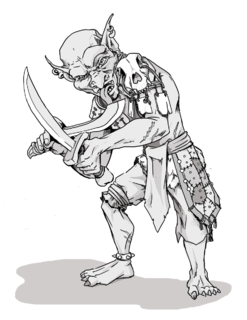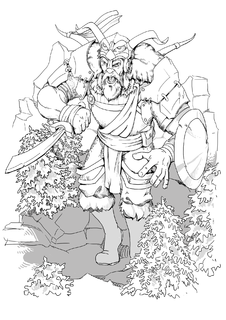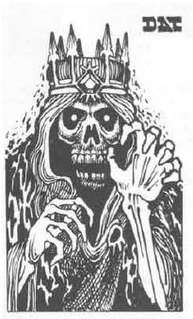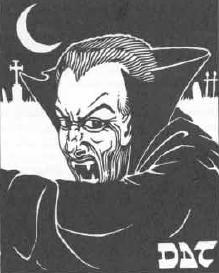
Lizardfolk are a fictional humanoid species in the Dungeons & Dragons fantasy role-playing game, having appeared in every version of the game to date.

In the Dungeons & Dragons fantasy role-playing game, goblins are a common and fairly weak race of evil humanoid monsters. Goblins are non-human monsters that low-level player characters often face in combat.
In Dungeons & Dragons, Fey is a category of creatures. The fey deities are associated with the Seelie Court and the Unseelie Court. Titania is the general fey deity, with individual races like the Killmoulis who worship Caoimhin. Fey are usually humanoid in form and generally have supernatural abilities and a connection to nature. The Sylph is one creature which has a Fey appearance, but is officially recognized as an outsider creature type.

The bodak is an undead creature in the Dungeons & Dragons fantasy role-playing game that comes from the Infinite Layers of the Abyss.

In the Dungeons & Dragons fantasy roleplaying game, the cloaker is a type of fictional monster portrayed as being able to disguise its body to resemble a cloak when at rest. The cloaker pacifies victims with an eerie moan, and engulfs its prey within its body to help it eat the prey. The cloaker was introduced in the first edition Advanced Dungeons & Dragons game adventure module, Secret of the Slavers' Stockade as an ally to the adventure's antagonists. The cloaker subsequently appeared in the first edition Monster Manual II, and then appeared several times in the game's second edition, third edition, fourth edition and fifth edition.

In the Dungeons & Dragons role-playing game, ixitxachitl are a race of intelligent, aquatic beings that resemble small manta rays with barbed tails. They have an evil disposition and worship evil powers. They love to hunt marine humanoids, and then sacrifice or devour their catch.

In the Dungeons & Dragons fantasy role-playing game, an elemental is a type of creature. Elemental creatures are composed of one of the four classical elementals of air, earth, fire, or water.

In the Dungeons & Dragons fantasy role-playing game, nagas comprise a variety of similar species of intelligent aberrations with widely differing abilities and alignments.

In the Dungeons & Dragons fantasy role-playing game, giant is a type of creature, or in third edition, a "creature type".

The lich is an undead creature found in the Dungeons & Dragons (D&D) fantasy role-playing game. Liches are spellcasters who seek to defy death by magical means.

In the Dungeons & Dragons fantasy role-playing game, the vampire is an undead creature. A humanoid or monstrous humanoid creature can become a vampire, and looks as it did in life, with pale skin, haunting red eyes, and a feral cast to its features. A new vampire is created when another vampire drains the life out of a living creature.
In the Dungeons & Dragons fantasy role-playing game, the shadow is an undead creature.

A wight is an undead creature in the Dungeons & Dragons fantasy role-playing game.

In Dungeons & Dragons, a lycanthrope is a humanoid shapeshifter based on various legends of lycanthropes, werecats, and other such beings. In addition to the werewolf, in Dungeons & Dragons, weretigers, wereboars, werebears and other shapeshifting creatures similar to werewolves and related beings are considered lycanthropes, although traditionally, "lycanthrope" refers to a wolf-human combination exclusively.

In the Dungeons & Dragons fantasy role-playing game, the zombie is an undead creature, usually created by applying a template to another creature.

In the Dungeons & Dragons fantasy roleplaying game, the skeleton is an undead creature. In the third edition of the game, a skeleton's statistics are usually created by applying a template to those of another creature.

A treant is a fictional creature found in the Dungeons & Dragons roleplaying game.

The shadow dragon is a type of dragon in the fantasy role-playing game Dungeons & Dragons.
















